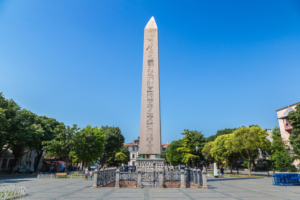The word “hippodrome” comes from the Greek word meaning hippos (horse) and dromos (way). It was built for conducting chariot races, the most admired sports of the Byzantine region (ancient Constantinople). Beyond races, this social centre served as an arena for social events including official ceremonies, celebrations, protests, executions, parades, and coronations.
 Located in the historic region of Sultanahmet (also known as Istanbul), the Hippodrome was the seat of power in three consecutive empires. Between 203-330 CE (Roman), the emperor Septimius Severus got the first Hippodrome built which was small and unfinished. Between 330-1453 CE (Byzantine), the emperor Constantine I rebuilt the unfinished Hippodrome and extended it connecting it with the great palace of Constantinople. Between 1453-1922 (Ottoman), the Hippodrome was renamed as ‘Horse Square’, then mainly used for Chariot racing.
Located in the historic region of Sultanahmet (also known as Istanbul), the Hippodrome was the seat of power in three consecutive empires. Between 203-330 CE (Roman), the emperor Septimius Severus got the first Hippodrome built which was small and unfinished. Between 330-1453 CE (Byzantine), the emperor Constantine I rebuilt the unfinished Hippodrome and extended it connecting it with the great palace of Constantinople. Between 1453-1922 (Ottoman), the Hippodrome was renamed as ‘Horse Square’, then mainly used for Chariot racing.
A few historic events:
1. From Egypt, the Obelisk of Thutmosis III was brought to Constantinople by the emperor Theodosius I. This was erected inside the Hippodrome and got named as “Obelisk of Theodosius”. This obelisk aged 3500 years still remains good even today;
2. During the Nika Riots in 532 CE, Byzantine emperor Justinian I ordered the execution of 30,000 people locked in the Hippodrome;
3. Throughout the Byzantine empire, this arena held the lives of about 40,000 people;
4. A-15 day long circumcision ceremony of the sons of Ahmet III took place in the Hippodrome during the Ottoman period in 1720;
5. Good performing charioteers were celebrated as heroes in days of yore. A lot of statues of several Charioteer were erected throughout the walls of the Hippodrome
Fall of the Hippodrome:
During the fourth crusade attack in the city, all the monumental structures in the Hippodrome were stolen by the invaders. Later, when the Blue Mosque and Ibrahim Pasa palace was built in the 16th and 17th centuries respectively, the arena was pulled down and forgotten long since ravaged by invaders.
Today, the large arena has turned into a public park with a road running around marking the racing track. Only the two Obelisks: the base of the Charioteer Porphyrios statue and the serpentine column will live forever for the rest of us.

